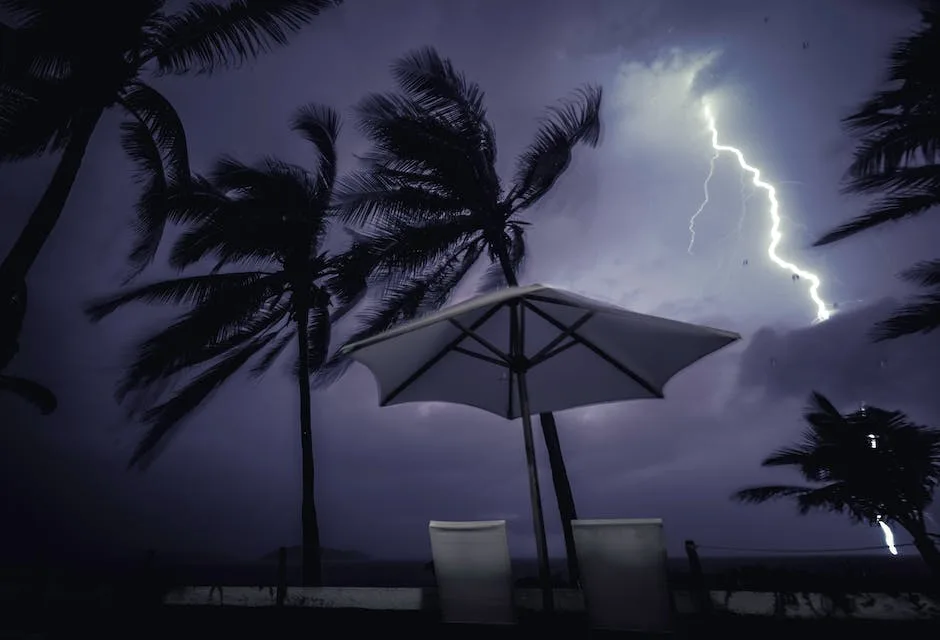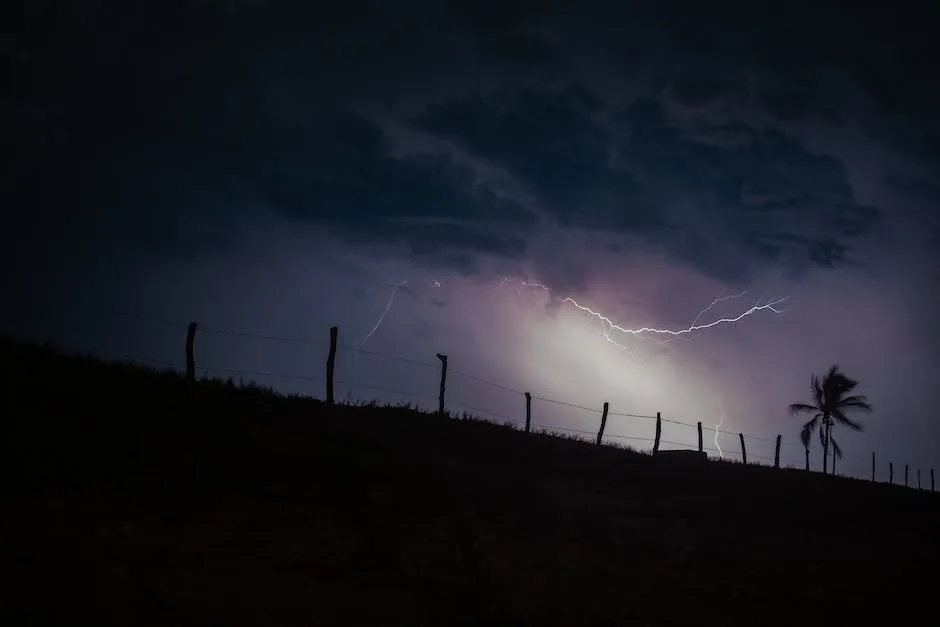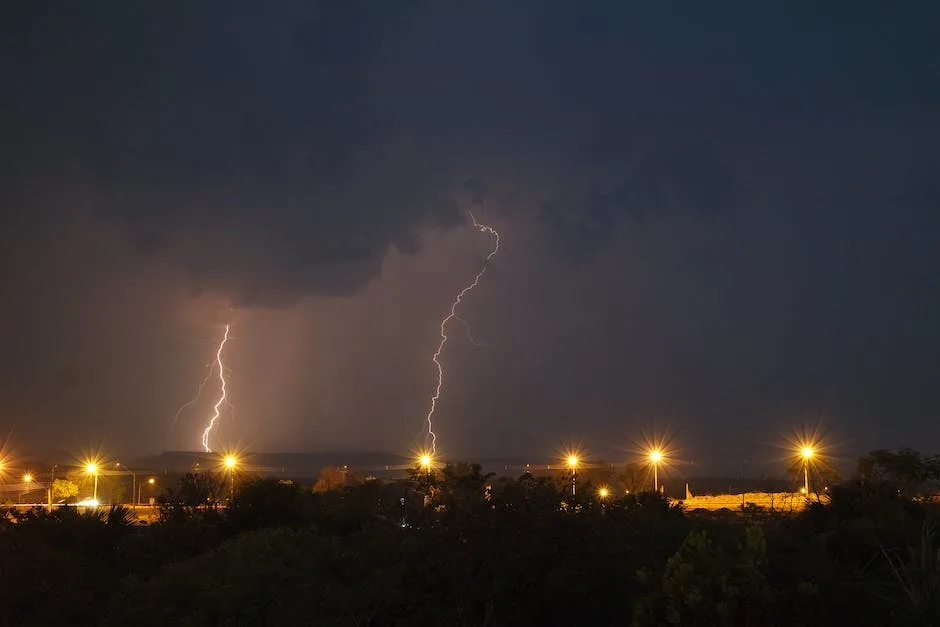A palm tree is a tall, slender tree with a crown of leaves at the top. The leaves are usually long and curved, and the trunk is smooth and sometimes spiny. Palm trees are found in warm climates all over the world.
Most palm trees can survive a lightning strike. The tree’s bark is thick and corky, which protects the tree from the heat of the lightning. The leaves of the palm tree are also tough and leathery, which helps to protect the tree from the force of the lightning strike.
Lightning typically strikes the tallest object in an area, making palm trees a common target. While a palm tree can survive a lightning strike, the bolt of electricity can cause serious damage to the tree. Often, the tree will lose all its leaves and branches, which can leave it weakened and vulnerable to disease. In some cases, the tree may even be killed outright.
Can a tree struck by lightning Be Saved?
Trees don’t heal like humans do. When they are wounded by lightning, they try to seal the wound off from the healthy parts. This is a natural process and the best thing you can do for your tree, in most cases, is to allow it to happen.
While it is true that the tallest objects are more likely to be struck by lightning, this is not the only factor that determines whether or not a tree will be hit. Oaks are by far the most likely trees to be hit, followed by elm, ash, yellow poplar, and pine. The reason for this is not entirely clear, but it may have something to do with the way that these trees conduct electricity. Whatever the reason, it is important to remember that all trees are potential targets during a thunderstorm and to take precautions accordingly.
Can a tree come back after being struck by lightning
There is no guarantee that a tree hit by lightning will recover. In some cases, it might steadily decline, depending on the amount of damage its internal structure, branches, and roots have suffered.
A strike from a lightning bolt can be absolutely devastating to a tree. The high voltage and temperatures can cause the tree to explode, or to lose great strips of wood and bark. For a tree that is unlucky enough to be hit by a lightning bolt, it is usually all over.
How long can a tree live after being struck by lightning?
Lightning-struck trees can indeed survive for many years if they are properly cared for and the initial injury is not too severe. Some trees have even been known to survive being struck more than once! With the right care, these trees can continue to thrive and provide beauty and shade for many years to come.
Lightning is a natural phenomenon that can cause serious damage to trees. Although trees are often the tallest objects in the landscape, their deep roots make them natural lightning rods, able to easily pass electric current from the air to the ground. This can cause the tree to split or catch fire, and can also damage the roots, making the tree more susceptible to wind and rain damage.
Does palm trees attract lightning?
Some palm species are more susceptible to lightning strikes than others, and the reason is unknown. According to experts, palms that are tall, in the open, or in small groups, and in relatively good health, are more likely to be struck by lightning. While there is no sure way to protect palms from lightning strikes, some experts suggest providing them with support or installing lightning rods.
The above mentioned trees are known to be struck by lightning more frequently as compared to other trees. This is because these trees have smooth bark which deflects lightning bolts better than rough-barked species.
What trees repel lightning
Holly and hazel trees were thought to be protected by Thor, the Norse god of thunder, and were thought to attract lightning strikes away from homes. Holly trees were usually planted a little distance from homes for this purpose.
Anytime a tree is struck by lightning, it can develop cracks in the bark. These cracks can sometimes split the tree open, or blow the bark back from the tree, breaking its branches. If there is more than one shock wave from the lightning, you may notice more splitting in the tree.
How long does it take for a tree to come out of shock?
It is important to be patient when transplanting trees, as it can take a few years for them to fully recover. In most cases, it takes a year or so for trees to shake off transplant shock, but occasionally it can take up to five years for them to get rid of all their stress symptoms. Therefore, it is important to be patient and give transplanted trees time to adjust to their new environment.
Lightning is one of the most powerful forces in nature. It can cause incredible damage to anything it touches. When a lightning bolt strikes a tree, the heat and electric sparks can often cause the tree to catch fire. The force of the strike can also split the tree in half or break off several branches. This damage can be incredibly destructive and can totally destroy a tree.
Why can’t you stand under a tree during a thunderstorm
Trees provide a natural path for lightning to travel into the ground. However, trees are not very good conductors of electricity. If you are standing under a tree during a thunderstorm, the current from the lightning can pass through your body.
Lightning is a very powerful force of nature that can cause major damage to trees. When lightning strikes a tree, it passes down the moist tissues and the extreme temperature prompts water inside the tree to turn into gas. Additionally, the electrical current from the bolt creates intense heating, often leading to the bark “virtually exploding” off in sizable strips. This can be extremely dangerous for anyone nearby and it is important to be aware of the potential damage that lightning can cause.
How many trees are struck by lightning each year?
We think around 830 million trees are struck by lightning, and about a quarter of those, around 200 million, are killed So that’s a lot.
Many trees have the potential of falling or losing limbs during wind storms, but some are more vulnerable than others. Factors that can cause weakening of trees include wood decay, injuries to the tree, and shallow root structure. Experts say that by paying attention to these factors, you can help to prevent problems before they happen.
Can a pine tree survive a lightning strike
As mentioned previously, trees can survive a lightning strike even one of obvious severity. However, soon after a tree is struck, espe- cially a pine, the tree is usually invaded by numerous bark beetles (Ips, Dendroctonus).
When palm trees are healthy, they rarely topple over due to wind, says arborist Wayne Tyson. He argues that their long, thin roots extend far and deep into the ground, which allows them to grow so tall and blow back and forth without breaking. However, in urban settings, these trees can face restrictions.
Are palm trees strong in storms
When it comes to hurricane-proofing your home, you might want to consider planting a palm tree.
That’s according to Neilson Meads, a forest ecologist and hurricane expert, who says that palm trees are uniquely adapted to withstand high winds and severe weather.
Meads says that the palm tree’s root system is designed to grip the ground tightly, making them difficult to uproot. Additionally, the trees are flexible and able to bend in high winds without breaking.
While there are no guarantees that your palm tree will withstand a hurricane, Meads says that they are more likely to survive than most other trees. So if you’re looking to add some hurricane protection to your property, a palm tree might be a good option.
Hurricane-force winds can cause trees to snap or lose branches, but palm trees typically bend during gusty weather. Palm trees are able to withstand strong winds due to their flexible trunks and leaves. Their leaves also act as a windbreaker, reducing the pressure on the trunk.
What attracts lightning to a house
Lightning is attracted to tall objects and objects that conduct electricity. Stay away from these objects when lightning is present. Inside your home, stay away from anything connected with wires or piping (TVs, lights, appliances, faucets, etc).
Trees can vary greatly in their resistance to wind damage, with some trees being much more resistant than others. Some of the most wind-resistant trees include laurel oak, southern red oak, water oak, pecan, Chinese elm, tulip poplar, spruce pine, and Leyland cypress. When choosing trees for wind resistance, it is important to consider both large and small trees, as both can be affected by high winds.
Where does lightning strike the least
The North and South Poles and the areas over the oceans have the fewest lightning strikes. The reasons for this are not fully understood, but it is thought that the Earth’s magnetic field plays a role in protecting these areas from lightning.
You can install a tree lightning protection system to minimize your trees being harmed. A lightning protection system is basically a copper cable line that runs along the tree, intercepting a lightning bolt and guiding it to the ground opposed to striking the tree.
Where are you most likely to get struck by lightning
If you live in Florida, you’re at a much higher risk of being struck by lightning than if you live in any other state. In fact, Florida is by far the most dangerous state when it comes to a person’s chances of being struck by lightning. lightning strikes are more common in Florida than anywhere else in the US, so it’s important to be aware of the risks and take precautions to protect yourself.
There are a few simple things you can do to minimize your risk of being struck by lightning: avoid being outdoors during thunderstorms, stay away from tall objects that could act as a lightning conductor, and don’t shelter under trees. If you are outdoors during a thunderstorm, make sure you’re not the highest point in the area and stay away from bodies of water. If you can hear thunder, you’re close enough to be struck by lightning, so take cover immediately.
Lightning strikes are incredibly dangerous and can cause serious injuries or even death. If you live in Florida, or if you’re planning to visit Florida during the summer months, make sure you’re aware of the risks and take steps to protect yourself.
When transplanting a tree, it is important to take care not to let the roots dry out. Reducing top growth can help the tree to keep the water where it is needed. Additionally, it is important to remove any weeds or unwanted plants near the newly planted tree that might be competing for moisture. Finally, consider adding a root booster to the transplant.
How long does transplant shock last for palm trees
Transplant shock is a common phenomenon that can occur when a tree is moved from one location to another. It can take a week or two for the shock to start and can last up to 2-4 weeks. There is no need to panic if your tree starts to look sick after transplanting, as this is perfectly natural. However, if your tree still looks sick after 6 weeks, it is advisable to give the nearest tree care company a call.
If enough of the root system is destroyed or detached, the tree will die. As a general rule, 20% of the root system can be destroyed before the tree will show signs of injury. If 40% of the root system is lost, the tree will probably die. It should also be removed because it is hazardous.
Warp Up
It is possible for a palm tree to survive a lightning strike, but it is not very likely. The palm tree would need to be struck in just the right way in order for it to survive.
While a palm tree may be able to survive a initial lightning strike, it is likely that the tree will sustain some level of damage. Lightning is a powerful force and can easily cause major damage to a tree, even if it is a palm tree. It is important to remember that while a palm tree may be able to survive a lightning strike, it is not guaranteed and the tree may still sustain some level of damage.
I’ve always been drawn to trees.
As a kid, I spent most of my free time outside, climbing, exploring, and trying to figure out the names of the trees around me.
That early curiosity eventually led me to study arboriculture and horticulture at Michigan State.
Later, I completed a degree in forestry at the University of Michigan.
I’ve been working in tree care and education ever since.
These days, I enjoy helping people learn more about the trees in their own backyards.
How they grow, how to care for them, and why they matter.
You don’t need to be an expert to appreciate trees.
A little curiosity goes a long way.
